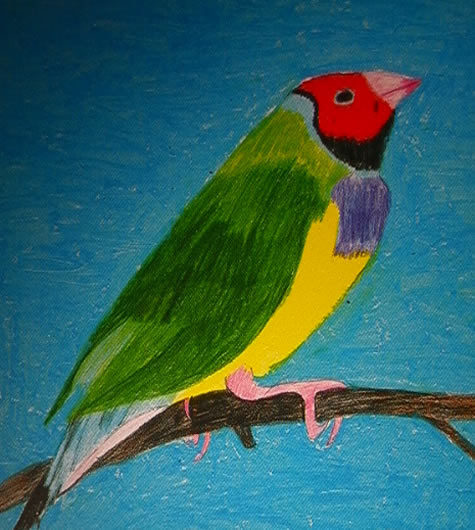THEME: Birds
SUBJECT AREA: Sustainability
TOPIC: Gouldian Finch
2001 October 17, Wednesday
“It was with feelings of the purest affection that I ventured to dedicate this lovely bird to the memory of my late wife.” John Gould, 1865.
Historical records indicate that the Gouldian Finch was once abundant across tropical northern Australia, from the Kimberleys to northwestern Queensland. Although protected, their numbers have dwindled rapidly from Western Australia, through the Northern Territory, with a small population located in central northern Queensland.

Reason for population decline may be attributed to trapping (they were trapped and exported by the thousands), changes to their habitat caused by inappropriate burning practices, and disease (infection caused by a lung mite).
During the Dry season and early Wet, the Gouldian Finch lives in grassy woodlands. They prefer rocky and hilly country.
Gouldians eat grass seeds and prefer native sorghum. During the Wet, sorghum becomes scarce and the finches resort to more common grass seeds. They drink from small water holes that are surrounded by vegetation as it offers protection from pythons and goannas.
Gouldian Finches are the only Australian finches to nest exclusively in tree hollows. The Snappy gum and Salmon gum are the two types of Eucalypts they prefer for their nests. They build a grass cup nest and lay 4-8 eggs. Predators that prey on the nest (and sometimes the parents!) are goannas or Brown tree snakes.
To manage the Gouldian Finch population for conservation purposes, it is important to know how many are living and if the population is declining, stable, or increasing. Their breeding and nesting habitats are also under observation.
To answer these questions, the Conservation Commission carries out a banding program to track the patterns and growth of the finches. This study involves netting these finches around water holes and placing a numbered aluminium band around the right leg of each bird. Banding sites are monitored each year and recaptured birds are identified and recorded.
Suggested learning activities: What types of birds in your area are endangered and under protection? How are their numbers monitored to control populations and promote growth, if possible? Are their habitats threatened and, if so, in what way? What can be done to protect the natural environment of these birds?
April